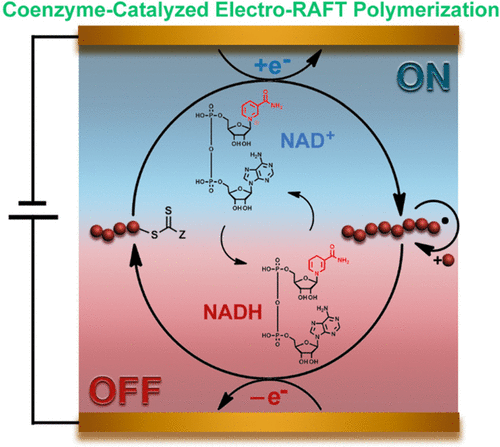当前位置:
X-MOL 学术
›
ACS Macro Lett.
›
论文详情
Our official English website, www.x-mol.net, welcomes your feedback! (Note: you will need to create a separate account there.)
Coenzyme-Catalyzed Electro-RAFT Polymerization
ACS Macro Letters ( IF 5.8 ) Pub Date : 2017-11-16 00:00:00 , DOI: 10.1021/acsmacrolett.7b00886 Wei Sang 1 , Miaomiao Xu 1 , Qiang Yan 1
ACS Macro Letters ( IF 5.8 ) Pub Date : 2017-11-16 00:00:00 , DOI: 10.1021/acsmacrolett.7b00886 Wei Sang 1 , Miaomiao Xu 1 , Qiang Yan 1
Affiliation

|
Here we report an electrochemically switchable reversible addition–fragmentation chain transfer polymerization (eRAFT). A new family of biochemical coenzymes are discovered that can be used as highly efficient electroredox catalysts to mediate this polymerization. The oxidation of coenzyme, nicotinamide adenine dinucleotide (NADH), can promote the reduction of a chain transfer agent, triggering generation and propagation of polymer radicals. External potential can activate the reduction of the NAD+ oxidized state and pause the propagation. Tuning the applied potential to reversibly switch the catalyst between its reduced and oxidized states can toggle the polymerization between ON and OFF states. This new strategy is universal to a broad scope of monomers, and ppm-level coenzymes result in the desirable polymer structures with targeted molecular weight, dispersity, and excellent chain-end fidelity. We envisage that the bioorganic-based catalysts would open new directions of organocatalyzed electro-controlled polymerization and be of value in electrocatalysis for well-structured polymers.
中文翻译:

辅酶催化电筏聚合
在这里,我们报告了一种电化学可切换的可逆加成-断裂链转移聚合(e RAFT)。发现了一个新的生化辅酶家族,可以用作高效的电氧化还原催化剂来介导这种聚合。辅酶烟酰胺腺嘌呤二核苷酸 (NADH) 的氧化可促进链转移剂的还原,引发聚合物自由基的产生和传播。外部电位可以激活 NAD +的还原氧化状态并暂停传播。调整施加的电位以在其还原态和氧化态之间可逆地切换催化剂可以在开启和关闭状态之间切换聚合。这种新策略对广泛的单体具有通用性,ppm 级的辅酶可产生具有目标分子量、分散性和出色链端保真度的理想聚合物结构。我们设想基于生物有机的催化剂将开辟有机催化电控聚合的新方向,并在结构良好的聚合物的电催化中具有价值。
更新日期:2017-11-16
中文翻译:

辅酶催化电筏聚合
在这里,我们报告了一种电化学可切换的可逆加成-断裂链转移聚合(e RAFT)。发现了一个新的生化辅酶家族,可以用作高效的电氧化还原催化剂来介导这种聚合。辅酶烟酰胺腺嘌呤二核苷酸 (NADH) 的氧化可促进链转移剂的还原,引发聚合物自由基的产生和传播。外部电位可以激活 NAD +的还原氧化状态并暂停传播。调整施加的电位以在其还原态和氧化态之间可逆地切换催化剂可以在开启和关闭状态之间切换聚合。这种新策略对广泛的单体具有通用性,ppm 级的辅酶可产生具有目标分子量、分散性和出色链端保真度的理想聚合物结构。我们设想基于生物有机的催化剂将开辟有机催化电控聚合的新方向,并在结构良好的聚合物的电催化中具有价值。



























 京公网安备 11010802027423号
京公网安备 11010802027423号